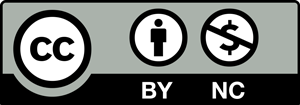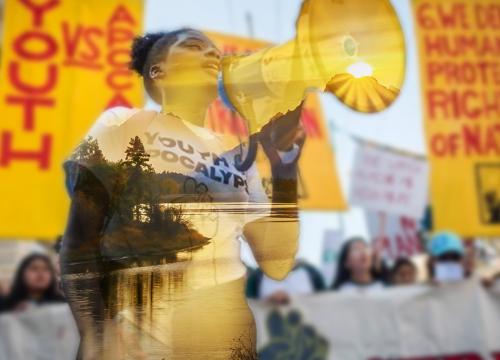Right Here Right Now: Solutions Educator Guide
Theme Three: Solutions
Begin by selecting one of the four themes below. Work through at least one activity listed in the theme with your students, then read through one of the stories and explore the ways to engage. Many activities and lessons have been chosen from the Climate Literacy and Energy Awareness Network (CLEAN) and include a teacher’s guide on how to best bring these lessons and activities into the classroom. For more information about CLEAN resources as well as support for teaching about climate energy, please visit the CLEAN website.
Guide Structure
Each section of the guide adheres to the following format to scaffold the learning I) activities and lessons, ii) stories, and iii) ways to engage youth. By beginning the engagement with the conference content via an activity, students learn about different aspects of the theme. Stories are the second element of the educator guide. The stories strive to connect students to the people and places impacted by climate change and create empathy. Ways to engage in each theme is the focus of the final resource section of the guide. After exploring a topic and who it impacts, learning about how youth can take action will allow students to find hope, energy, and purpose while exploring topics that may feel overwhelming.

Goals Header
What Students Will Do
- Begin by selecting one of the six themes below. Work through at least one activity listed in the theme with your students, then read through one of the stories and explore the ways to engage
Description
Mitigation: Efforts that reduce greenhouse gas emissions from human activities
Activities and lessons
Renewable Energy Living Lab: Smart Solar, Mike Mooney, Minal Parekh, Scott Schankweiler, Jessica Noffsinger, Karen Johnson, Jonathan Knudtsen, University of Colorado; Colorado School of Mines- https://cleanet.org/resources/49469.html
-
Description: In this activity, students work through the process of evaluating the feasibility of photovoltaic solar power in 4 different US cities.
-
Instructional Time: Activity will take about one 60-minute class period.
-
Grade Level: Grades six through twelve
Wind Energy: Exploring Wind Farms with Google Earth, Lehigh University- https://cleanet.org/resources/45598.html
-
Description: In this activity, students use Google Earth to investigate ideal features of wind farms.
-
Instructional Time: Activity takes about 1-2 class periods. Google Earth software (free download) is required.
-
Grade Level: Grades six and up
Using a mass balance model to understand carbon dioxide and its connection to global warming, Robert MacKay, SERC - Teaching Quantitative Skills in Geoscience Collection- https://cleanet.org/resources/41868.html
-
Description: Students explore the increase in atmospheric carbon dioxide over the past 40 years with an interactive online model. They use the model and observations to estimate present emission rates and emission growth rates. The model is then used to estimate future levels of carbon dioxide using different future emission scenarios. These different scenarios are then linked by students to climate model predictions also used by the Intergovernmental Panel on Climate Change.
-
Instructional Time: Activity takes two to three hours. Computer access necessary.
-
Grade Level: Grades nine and up
Stories
Is your carbon footprint BS?, How to Save a Planet podcast
What a rapid transition from fossil fuels to carbon-free energy alternatives looks like, The Hill
A climate change solution that's right under our feet, Asmeret Asefaw Berhe TED Talk
- https://www.ted.com/talks/asmeret_asefaw_berhe_a_climate_change_solution_that_s_right_under_our_feet
Ways to Engage
Make a Climate Pledge with the Re-Earth Initiative
Take part in or start a climate strike with Fridays for the future
Get involved with the Solar Decathlon
Adaptation
Measures that are participatory, gender-responsive, adequately resourced, reduce vulnerability, and build the resilience of people and communities most affected by climate change.
Activities and lessons
Adapting to a Changing World, Becca Walker, Mt. San Antonio College, InTeGrate; SERC- https://cleanet.org/resources/49445.html
-
Description: In this activity, students assess individual and national opinions on climate change and explore strategies that communities are employing to adapt to aspects of climate change already affecting them in addition to those likely to affect them in the future.
-
Instructional Time: This activity takes about one 50-minute class period.
-
Grade Level: Grades nine and up
Rising Tides: Protect Your Home from the Waves, Kate Carter, National Center for Science Education- https://cleanet.org/resources/58410.html
-
Description: Warming oceans and melting landlocked ice caused by global climate change may result in rising sea levels. This rise in sea level combined with increased intensity and frequency of storms will produce storm surges that flood subways, highways, homes, and more. In this activity, visitors design and test adaptations to prepare for flooding caused by sea level rise.
-
Instructional Time: This activity takes one 45-90 minute period
-
Grade Level: Kindergarten and up
HEART Force Wildfire Game, Cooperative Institute for Research in Environmental Sciences, University of Colorado Boulder- https://cleanet.org/resources/58192.html
-
Description: In this interactive game, students solve the challenges that their community faces during the course of a wildfire event by using available individual and community resources. Students work in three zone response teams to determine their responses in each round as the wildfire situation evolves.
-
Instructional Time: This activity takes one 60-minute class period.
-
Grade Level: Grades six through twelve
Stories
A Young Scientist's Guide to Problem Solving and Innovation | Gitanjali Rao (Day 2 panelist) | TEDxChennai
Young Jordanians innovate to tackle food insecurity, UN News
How much warmer is your city?, BBC Visual and Data Journalism team
Ways to Engage
Learn about climate policy in your state to see what additional adaptation policies are needed:
Choose an action for climate adaptation in your region recommended by the EPA
Work with your city and local Universities to join the EPIC Network (Educational Partnerships for Innovation in Communities Network)
International Cooperation
Cooperation in technology transfer, financing, judicial, and redress mechanisms.
Activities and lessons
Energy culture as a determinant of a country’s position in the climate talks, Tatyana Ruseva, Appalachian State University, CLEAN Community Collection- https://cleanet.org/resources/49913.html
-
Description: In this activity, students compare countries and nation states with high- and low-energy consumption rates within a specific region of the world. Students are encouraged to draw linkages between a country's energy culture and its position in multilateral climate negotiations.
-
Instructional Time: Activity takes about 2-3 class periods.
-
Grade Level: College
Gulf Stream Heat Budget and Europe's Mild Climate: A Problem-based Learning Activity, Warren C. Tomkiewicz, Plymouth State University , From the On The Cutting Edge activity collection- https://cleanet.org/resources/42693.html
-
Description: In this role-playing activity, learners are presented with a scenario in which they determine whether the Gulf Stream is responsible for keeping northern Europe warm. They must also address the potential future of the Gulf Stream if polar ice were to continue melting. The students work in small groups to identify the issue, discuss the problem, and develop a problem statement. They are then asked what they need to know to solve the problem.
-
Instructional Time: Activity takes two class periods plus homework assignment. Computer with internet access necessary.
-
Grade Level: Grade nine and up
Climate Action Simulation, Climate Interactive- https://cleanet.org/resources/58166.html
-
Description: This interactive role-playing simulation is conducted as a simulated emergency climate summit organized by the United Nations that convenes global stakeholders to establish a concrete plan that limits warming to Paris Agreement goals. This game is a fun format for large groups to explore climate change solutions and see what it would really take to address this global challenge.
-
Instructional Time: This activity takes two to four 60-minute class periods
-
Grade Level: Grades nine and up
Stories
What does it mean to be a citizen of the world?, TED talk by Hugh Evans
Global cooperation to protect the ozone layer can ensure a better future for us all, UN News
How we can make the world a better place by 2030, Michael Green TED Talk
Ways to Engage
Take action on the UN Sustainable Development Goals
Choose an action from the Ecochallenge “Land Sinks” category
Join the Extinction Rebellion
Strengthened Accountability Mechanisms
Periodic revision and renewal of nationally determined contributions, creating a window of opportunity to promote human rights policy coherence.
Activities and lessons
Simulation of international negotiations to reduce greenhouse gas emissions, David Hastings, Eckerd College , From the On the Cutting Edge activity collection- https://cleanet.org/resources/42692.html =
-
Description: In this activity, students engage in a simulation of the international negotiation process in order to convey how the international community is responding to climate change. Participants learn firsthand about the interests of different countries and the range of policy responses to mitigate future climate change.
-
Instructional Time: Activity takes four class periods plus homework assignments.
-
Grade Level: College
The Paris Climate Agreement for Young People, United Nations Children’s Fund - https://www.unicef.org/lac/en/reports/paris-agreement-young-people
-
Description: This guide provides an easy-to-understand overview of the Paris Climate Agreement. While a lesson plan isn’t included here, understanding the agreement is incredibly helpful when discussing accountability. For the lesson, read through this document and discuss as a class.
-
Instructional Time: One class period
-
Grade Level: Grades six and up
Global Energy Flows, Great Lakes Bioenergy Research Center, U.S. Department of Energy- https://cleanet.org/resources/44615.html
-
Description: In this activity, students analyze data detailing global energy sources and sinks (uses) and construct a diagram to show the relative scale and the connections between them. Discussions of scale; historical, socio-environmental, and geographic variation in this data; and implications for future energy use are included.
-
Instructional Time: Activity takes one to two 50-minute class periods.
-
Grade Level: Grades nine and up
Stories
Why this Indigenous rights activist does not take clean water for granted, RHRN story on Tia Kennedy
How are countries held accountable under the Paris Agreement?, MIT Climate Portal
My Climate Reality, stories from youth climate activists around the world, Mock COP
Ways to Engage
Join a 350.org campaign
Read the Greenpeace guide on holding your government accountable for climate change and take action
Connect your school and community to the UN Youth2030 Action Guide



